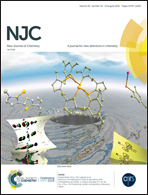A novel two-photon fluorescent probe for detecting FA based on a coumarin derivative and its applications in living cells, zebrafish and tissues†
Abstract
Formaldehyde (FA), a well-known carbonyl species, plays a crucial role in physiological function and is produced endogenously via enzymatic pathways. However, an abnormal concentration of FA is closely related with various types of diseases, including Alzheimer's disease, cancer and diabetes. Thus, it is significant to real-time visualize the changes in FA in organisms. In this study, we engineered a unique two-photon probe for sensing FA based on a coumarin derivative as a two-photon reporter and a homoallylamino group as the responsive site. In the presence of FA, the probe showed good selectivity, a low detection limit and high stability. Significantly, its successful application in living cells and zebrafish showed that this probe has the ability to sense FA with the desirable two-photon mode. Moreover, with its feature of high resolution, the three-dimensional imaging of living tissues exhibited remarkable fluorescence signal changes with/without the treatment of FA with this probe in the two-photon mode. Therefore, this probe is a powerful molecular tool for sensing FA in living systems.



 Please wait while we load your content...
Please wait while we load your content...